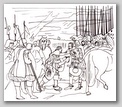The keys to the city gates remained a symbol of the inhabitants’ right to self-determination as late as the 18th century. If a city had to surrender to an attacking army, this was symbolized by the keys to the city being turned over to the conquerors.
 |
| Diego Velázquez, “The Surrender of Breda, 1625.” Sketch by the author. |
The Prado museum in Madrid has a four-meter long painting made by Diego Velázquez in 1634–35, “The Surrender of Breda (1625).” The painting depicts the Dutch governor of Breda, Justin de Nassau, humbly handing over the key to the city to Spanish general Ambrosio de Spinola.
 |
| Scene from the Bayeux tapestry. Sketch by the author. |
The Bayeux tapestry contains a scene from the middle of the 11th century, in which Duke Conan, locked in the tower of the city of Dina, resignedly hands over the keys to the city to the commander of the attacking Normans, Duke William the Conqueror. Just in case, Conan holds the keys on the sharpened tip of his lance. William seems to be accepting his surrender as he takes the keys on his own lance.